| Home > Policy > White Paper, Notice, Announcement > White Paper > Japanese Government Policies in Education, Science, Sports and Culture 2000 > Part 1 Chapter 1 Section 2 2 | ||
| {1} Music |
(a) Overview of the Music Community
"Music" includes such fields as orchestra, opera, chorus, and chamber music, and a large number of activities are conducted in each field. Also, groups that pursue new musical styles through Japanese traditional musical instruments and folk instruments, and groups that perform Western music from the Renaissance and Baroque periods are achieving significant results. According to the Japan Council of Performers' Organizations' "Performing Arts Data Book 1999," as of 1997, there were approximately 3,270 public performances of orchestras, 500 operas, and more than 12,000 public performances of soloists, chamber music, and choruses combined.
Recently, the remarkably high standard of Japanese performers has come to be recognized, as Japan has produced a number of prizewinners in international competitions, such as KASHIMOTO Daishin (violin) and SATO Mieko (soprano).
3,370 individual performers are members of the Japan Federation of Musicians.
Amateur musical activities are also flourishing; in particular, choruses and bands are being formed in circles and school clubs. Many who participate in these activities go on to become professional musicians. Approximately 3,000 organizations are members of the Japan Choral Association and 13,000 are members of the All Japan Band Association. Each association conducts a variety of activities, such as holding nation-wide competitions.
(b) Orchestra
After the end of World War II, the activities of the present-day Tokyo Philharmonic Orchestra and the NHK Symphony Orchestra were resumed, and new orchestras have been established one after another. By around 1965, the main orchestras in Japan today had commenced activities, primarily in Tokyo where there were relatively large audiences. Since then, local and independently-run orchestras have been established. 24 major Japanese orchestras are members of the Association of Japanese Symphony Orchestras.
As a representative field of classical music, orchestras have acquired a comparatively wide audience, but are somewhat disadvantaged financially due to their need for a great number of members. The fact that the increase in the number of orchestras does not necessarily accord with the larger audiences, and the uneven geographic distribution of orchestras have also been pointed out as key issues.
Various other trends are also being observed; for example, the Tokyo Philharmonic Orchestra and the Shinsei Nihon Symphony Orchestra are expected to merge in April 2001.
(c) Opera
The first opera performance by Japanese was Gluck's "Orpheus" performed at the Tokyo School of Music Auditorium in 1961. During the Taisho period (1912-1926), the Asakusa Opera enjoyed a wide audience. After the war, private opera groups represented by the Fujiwara Opera and the Nikikai played an important role in opera activities in Japan. Each of these opera groups emphasized the cultivation of opera singers by establishing their own training institutes. Local opera activities have also flourished since the late 1960s, and have recently achieved remarkable success.
At present, although seven opera groups are members of the Opera Group Council, there are many other organizations conducting their own distinctive activities. 158 organizations are published in the Opera Group Council's Japan Opera Almanac 1998. The New National Theater opened its opera theater in 1997, and it is expected to further enhance the level of Japanese opera performances and draw more crowds.
(d) Popular Music
Popular music involves a wide variety of fields, including general songs, rock, and enka (popular Japanese ballads). According to Dentsu Inc.'s "2000 White Paper on Information Media," in 1998, the number of people who attended popular music concerts comprised approximately 70% of total music performances and over 90% of total record sales. Although open-air concerts with a turnout of 200,000 have been held, and sales of products have exceeded 8.5 million, the Recording Industry Association of Japan's "Japan's Recording Industry 2000" indicates that total record sales are experiencing sluggish growth.
Overseas, particularly in Asia, interest in Japanese popular music is on the rise, due to magazines, CDs, and satellite broadcasting. Also, many companies have begun to offer fee-based distribution services through the Internet.
| {2} Dance |
(a) Overview of the Dance Community
Currently, dance being performed in Japan can be divided largely into Japanese-style dance and Western-style dance. Japanese-style dance includes Japanese classic dance, folk dances, and Noh dances. These will be described later as "traditional performing arts."
Western-style dance, on the other hand, can be divided broadly into ballet and modern dance, and also includes traditional folk dances, such as flamenco (a representative dance of Spain), hula dancing, and various folk dances, as well as social dancing.
Ballet was first introduced to Japan in the first year of the Taisho period (1912) by an Italian named Rossi who had been invited to the Imperial Theater, and soon became extremely popular amongst the Japanese people. Today, the technical skill level of young Japanese dancers compares favorably with other dancers internationally.
Like ballet, modern dance was also introduced during the early Taisho period by Germany, but as it has the advantage of being a more free style of dance than ballet, it spread throughout Japan more quickly. After World War II, activities conducted by Japanese dancers in this field became increasingly diverse due to influences from Europe and the United States. One example is the appearance of the style called Butoh, a uniquely Japanese form of dance which has come to be regarded very highly internationally. Although modern dance has long been called "modern dance," recently, the tendency, especially among younger dancers, to call it "contemporary dance" is increasing. Many of these dancers are active internationally.
Traditional folk dances are often enjoyed individually, as a hobby, and many different forms have been seen. There are a large number of fans of Spanish dance in Japan, and the artistry of some dancers, who pursue it as more than just a hobby has long been recognized. Many award-winning Japanese dancers, such as KOMATSUBARA Yoko and KOJIMA Shoji, are also active in Spanish dancing.
In social dancing, men and women dance together, and dancers compete to demonstrate these techniques at competitions. In recent years, social dancing has become particularly popular with middle-aged people.
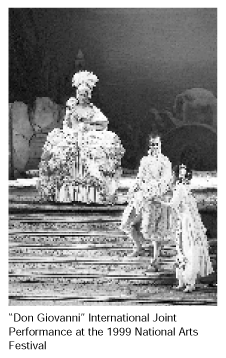
(b) Western-style Dance Organizations and Performances
As of 2000, there were 44 ballet troupes, 38 modern dance companies, 13 butoh groups, and nine Spanish dancing groups in Japan. Ballet dancers all over the country are members of the Japan Ballet Association. In addition, the Tokyo Ballet Association is made up of four organizations: the Star Dancers Ballet, the Tchaikovsky Memorial Tokyo Ballet, the Tokyo City Ballet and the Asami Maki Ballet. Many modern dancers belong to a national organization called the Contemporary Dance Association of Japan, in which Spanish dancers also participate.
According to the aforementioned "Performing Arts Data Book 1999," in 1997 there were 679 performances of ballet, 617 performances of modern dance, 295 performances of butoh, and 278 performances of flamenco.
Most ballet performances are planned and produced by each individual ballet troupe, but some are performed through the Japan Ballet Association. Each ballet troupe normally performs using its own members, but sometimes also invites principal dancers from other ballet troupes or unaffiliated dancers for guest appearances.
Modern dance and Spanish dance are generally performed by individual dance groups, but dancers who are active either individually or in small groups generally present their works in recitals or in performances sponsored by the Contemporary Dance Association of Japan.
(c) Western-style Dance in Local Areas
National dance organizations have established branches in various regions to use as a base for dance activities in local areas. There are also independently active dance organizations in local areas, such as the Saitama Dance Association.
Ballet training facilities have been established nationwide; the most popular are primarily concentrated in metropolitan areas such as Tokyo.
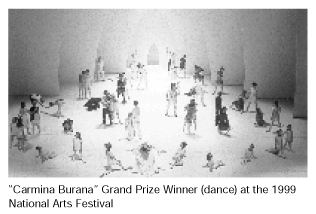
| {3} Theater |
(a) Overview of the Theater Community
Presently, a variety of theater works are being presented in Japan, but they can be classified primarily into five fields: traditional drama, new drama, little theaters, commercial theater, and musicals. Excluding traditional drama, these four fields are collectively called "modern drama," but active and mutual exchange as well as the sharing of influences is resulting in the weakening of clear divisions between each individual field.
New drama, or drama based on realism, developed out of the two pillars of productions of translations of foreign theatrical works and theatrical works written by Japanese playwrights. Many theater companies which were created immediately before or after World War II have repeatedly merged and split over the direction in which the group should progress, but after the war, the theater world came to be dominated by three companies: the Bungakuza, the Haiyuza, and the Mingei.
After about 1960, there was a tendency to search out new styles of drama, such as absurdist drama, but during the late 1960s, there was an attempt to move beyond conventional new drama. This created a boom in so-called "little theaters" and underground theaters, primarily among the younger generation.
Commercial theater is a type of drama that features extremely popular and well-known actors in leading roles, and has continued to be performed, mainly supported by large theaters such as the Toho Group, since the late 1950s.
The popularity of musicals has been steadily increasing thanks to performances by the Takarazuka Revue Company (which has existed since before the war), Toho, and the Shiki Theatrical Company. Even now, they are still able to draw large crowds. Although most are performances of the translations of works reviewed on New York's Broadway or London's West End, works produced in Japan have also been successful.
(b) Types of Performances
According to the aforementioned "Performing Arts Data Book 1999," 42,814 performances of new drama or little theater and 10,125 performances of commercial theater or musicals were held in 1997. Performances of new drama or little theater are largely conducted by theater companies. However, performances of commercial theater and musicals are organized by planning and production groups or theaters, which generally assemble directors and actors for each "production." This form is common in the West, and many stage actors in Europe and the United States are not affiliated with a theater companies but rather receive individual jobs through auditions, etc.
Recently, the number of such "productions" in the contemporary theater world in Japan has tended to increase, with many co-stars no longer bound by the framework of established theater companies. While performances by theater companies have begun to make use of characteristics of each group and close relationships among actors, the advantage to "productions" is that they are centered on the work itself and are able to consider the cast.
(c) Management of Theater Companies
Approximately 70 theater companies are members of the Association of Japanese Theatre Companies, but it is said that, including amateur groups, the total number of performance groups exceeds 1,000. Long-running productions such as highly successful large-scale musical performances and theater companies which are able to employ the so-called "repertory system" (in which they possess a large number of established works which they can perform at any time) are rare-it is conjectured that most theater companies would be unable to survive on operating profits derived from arts activities alone.
(d) Performances in Local Areas
The majority of theatrical performances are in urban areas. Local areas continue to steadily conduct activities such as the holding of the Traveling Arts Festival and theater appreciation events, but there is a gap in the opportunities for theater appreciation available in urban and local areas. However, recently, theaters based in local areas have begun to expand their activities, such as the Hirosaki Theater and the Hyogo Prefecture Piccolo Theater, fostering hopes for the revitalization of theatrical performances in local areas.
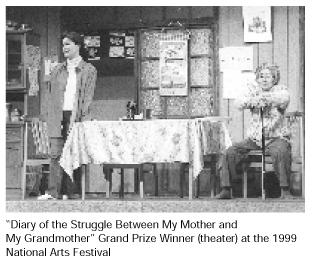
| {1} Overview of Japanese Traditional Performing Arts |
The basic nature of each of Japan's traditional performing arts was established as a fixed form prior to the Edo period (1600-1868); combined with new works and techniques to respond to the changing times, they have been continually passed down to the present day.
Traditional performing arts include stage arts performed on stage at theaters, halls, and Noh theaters, as well as folk performing arts conducted by various people at festivals and annual events in regions throughout Japan.
Stage arts are comprised of dramatic performing arts, music, dance, and other performing arts. Dramatic performing arts include Gagaku (Japanese court music), Nogaku, Ningyo Joruri Bunraku (puppet theater), Kabuki, and Okinawan Kumiodori, which combines music, acting, and dance. The field of music contains biwa (lute), shakuhachi (flute), and sokyoku (harp) performances, as well as various forms of shamisen music such as Nagauta (epic songs), Gidayubushi (dramatic narratives) and Tokiwazubushi (lyrical narrative) and traditional Ryukyu music which centers around the Okinawan sanshin harp. The field of dance includes Kabuki dances and Kamigatamai, and, separately, traditional Ryukyu dances from Okinawa. Other performing arts include narrative arts such as Rakugo (comic monologues), Kodan (historical narratives) and Rokyoku (storytelling accompanied by shamisen).
In addition, folk performing arts consist of dances and songs born and bred amidst the history and climate of particular regions, and can be divided into Kagura, Dengaku, and Furyu.
| {2} Overview of Each Field |
(a) Gagaku
Gagaku is made up of special wind and stringed instruments, such as the sho and the hichiriki, as well as dances. In ancient times, the performing arts of China from that period spread to Japan, succeeding to ceremonial performing arts in shrines and at the Imperial Court. Presently, this tradition is being kept alive by members of the Music Department of the Board of Ceremonies of the Imperial Household Agency.
There are 44 Gagaku performing groups in addition to the Music Department of the Imperial Household Agency (according to "Gagaku Appreciation" published by Bunkendo Shichiseisha).
Gagaku groups are generally affiliated with a particular shrine or temple, and perform for the public during events held by those shrines and temples.
The Music Department of the Imperial Household Agency works to spread Gagaku by holding concerts every spring and fall at the Imperial Palace, and performing at special appreciation events sponsored by local governments two or three times a year. Also, the National Theater, with the performances and cooperation of the Music Department of the Imperial Household Agency, has continually conducted one or two independent performances of Gagaku every year since it was opened. There are also groups such as the Tokyo Gakuso, the Japan Gagaku Society, and the Ono Gagaku Society, which conduct regular performances at theaters.
There have also been many individual Gagaku recitals; these are regarded very highly as cultural activities, as indicated by the fact that Gagaku performers were selected by the Agency for Cultural Affairs for an Arts Commendation in FY1986 and 1987.
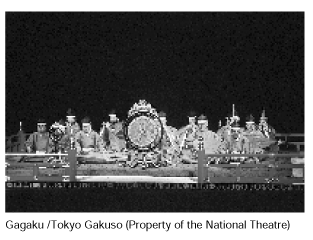
(b) Nogaku
Nogaku is made up of both the musical Noh drama and Kyogen comic dialogue. Almost all aspects of present-day Noh took shape during the Muromachi period (1333-1573), and it was supported primarily by the samurai warrior class throughout the Edo period.
Noh is divided into seven types of roles, each with its own school. Professional performers decide on one particular role to study. The roles in Noh are: Shite (main character), Waki (supporting character), Hayashi (instrumentalists)-flute, small drum, medium drum, and large drum-and Kyogen (comedic dialogue). A total of 24 schools have been passed down, including the five schools for Shite-the Kanze school the Hosho school, the Konparu school, the Kongo school and the Kita school.
In 1997, there were 1,524 authentic Noh performances conducted by professional Noh actors, 1,313 (86%) of which were typical performances in Noh theaters or halls and 211 (14%) of which were open-air Takigi Noh (torchlight) performances.
Also, according to the aforementioned "Performing Arts Data Book 1999," 61.5% of typical Noh performances were in Noh theaters, 24.9% were in halls, and 11.6% were in shrines.
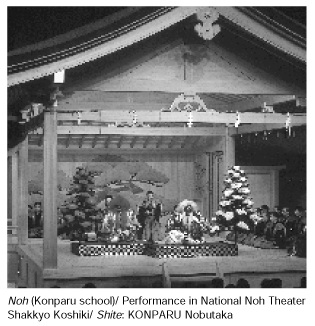
(c) Ningyo Joruri Bunraku (puppet theater)
Bunraku developed as a type of play using puppets in which Gidayubushi recite dramatic narratives accompanied by shamisen music. It was highly successful during the middle of the Edo period, with numerous performing groups, and this style continues to be passed down even today at the Ningyo Joruri Bunraku Troupe in Osaka. The Bunraku Association, established in 1963, is responsible for management of Bunraku promotion.
Bunraku is made up of Tayu (narrators) who tell the story, the shamisen played by the musicians, and the ningyo (puppets) which are operated.
The main Bunraku performances are held four months out of the year (performed 21 to 23 days out of the month) at the National Bunraku Theater in Osaka, and for three months out of the year (performed 16 days out of the month) at the National Theater's Small Theater in Tokyo. Furthermore, nationwide tour performances are given in various locations in January and March.
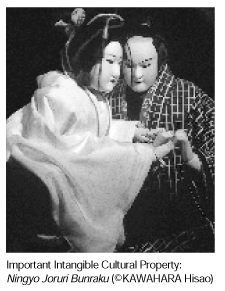
(d) Kabuki
Kabuki in its present state was largely developed during the Edo period, and is performed by actors and various musicians.
Kabuki actors, including actors of the Shinpa (New) school, are affiliated with the Japan Stage Players' Association of the New school. In addition, there is also an organization called Zenshinza which conducts performances of both kabuki, carrying on the traditions of kabuki, and modern drama.
Professional kabuki musicians perform three types of kabuki music: Takemoto (Gidayu narratives), Nagauta (music of the shamisen), and Narimono (various percussion instruments such as drums and bells). Shamisen music such as Tokiwazubushi and Kiyomotobushi is also performed in Kabuki; depending on the program, Sokyoku, Katobushi and Shinnaibushi also play an active role.
According to the aforementioned "Performing Arts Data Book 1999," there were a total of 2,272 performances of Kabuki on 1,291 days in 1997. Also, a total of nine theaters held performances of Kabuki more than 20 days per year, including five theaters in Tokyo, such as the Kabukiza and the National Theater, as well as the Misonoza and Chunichi Theater in Nagoya, the Minamiza in Kyoto, and the Shochikuza in Osaka.
In the town of Kotohira in Kagawa Prefecture, the "Shikoku Konpira Kabuki Festival" has been conducted annually since 1985 at the Old Konpira Theater (Kanamaruza), an Edo-period playhouse that is an important cultural property. This has served as a model for the revitalization of small playhouses in other regions.
The Hakataza in Fukuoka, which opened in 1999, also plans to begin conducting Kabuki performances for more than a month per year. In addition, the number of facilities in various regions for the appreciation of Kabuki is on the rise, such as the Renaissance Nagato, which opened in March 2000 in Nagato City in Yamaguchi Prefecture and is equipped to present authentic Kabuki performances.
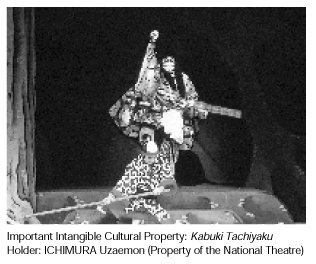
(e) Music
Japanese traditional music includes the biwa (lute), shakuhachi (flute), and the sokyoku as well as four styles of shamisen music: Nagauta, Kiyomoto, Gidayubushi, and Tokiwazubushi.
According to the previously-mentioned "Performing Arts Data Book 1999," in 1996 there were 1,706 performances of Japanese traditional music. Ensembles such as sokyoku and shakuhachi were the most popular, with 1,060 performances (62.1%), followed by shamisen, with 585 performances (34.2%), and biwa with 61 performances (3.5%). In general, traditional music performances have been held in separate fields, such as Gidayubushi, but recently, there have been a number of performances in conjunction with other forms of traditional music, or Western music. In 1996, there were 649 of such performances.
(f) Japanese Dance
Japanese dance has survived through various forms of dance performed in Kabuki during the Edo period. In the Kanto region, Kabuki dances based on the classics have served as a foundation for its style, whereas in Osaka and Kyoto, Kamigatamai dancing is performed, which involves movements from Noh. Both have become major styles of Japanese dance.
According to the previously-mentioned "Performing Arts Data Book 1999," there were 1,018 performances of Japanese dance in 1997, accounting for one-third of the 3,082 total performances of dance, including Western dance.
(g) Other Performing Arts
Other traditional performing arts include Rakugo (comic monologues), Kodan (oral storytelling), Rokyoku (reciting of ballads), Daikagura (Japanese traditional acrobatics) and Wazuma (traditional conjuring).
According to the aforementioned "Performing Arts Data Book 1999," in 1997 there were a total of 12,879 performances of other traditional performing arts, including Conte (short comedic skits). Performances of these other performing arts that are limited to particular fields (for instance, Rakugo festivals) are exceptions to the general rule. In particular, Daikagura and conjuring are rarely performed by themselves.
These performances are concentrated in Tokyo and Osaka.
(h) Okinawan Traditional Performing Arts
In Okinawa Prefecture, which maintains a culture that has been independent since the Ryukyu Kingdom era (1429-1879), distinctive traditional music centered around the sanshin (Okinawan shamisen) as well as traditional dance and the dramatic combination of music and dance called Kumiodori have been passed down.
Regarding Okinawa traditional performing arts, Kumiodori was designated as an Important Intangible Cultural Property in 1972 and its performers are recognized as members of the Traditional Kumiodori Preservation Society; in addition, support is being provided for performances and the cultivation of successors.
At present, preparations are being made for the opening of the National Kumiodori Theater (provisional name), which will serve as a base for the preservation and promotion of Okinawan performing arts.
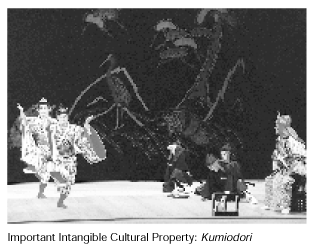
(i) Folk Performing Arts
Various folk performing arts are conducted by local people at festivals and annual events in regions throughout Japan. According to a survey by the Agency for Cultural Affairs, over 30,000 folk performing arts are being passed down nationwide.
These folk performing arts vary in content, depending on the region, and can be classified into Kagura (dances based on myths using bells and swords), Dengaku (songs and dances performed during the rice-planting season which act out scenes of rice cultivation), Furyu (where dancers attired in colorful costumes and hats dance to taiko drums) and "imported performing arts/stage arts" (regionally-based performing arts such as Noh and Bunraku.
Within the category of folk performing arts, those whose transmission is essential to our understanding of how Japanese lifestyles have changed (particularly those which appear to have been conducted prior to the Edo period) are designated as Important Intangible Folk-Cultural Properties based on the Law for the Protection of Cultural Properties, and government assistance is provided towards activities to foster successors.
Furthermore, traditional folk songs are the songs which were sung by general people living in various regions during their daily lives. These songs have become quite refined. Broadly speaking, they may include songs which accompany dances in "folk performing arts," but the more specific definition includes songs sung while doing various labor such as agricultural work like rice-planting or transportation using horses or cows or fishing from boats; songs of celebration at weddings or at newly-built sites; joyful songs at feasts; amusing songs; and nursery songs and lullabies. Originally, folk songs were closely related to people's lives, but because various manual labors were mechanized after the war, now, songs are rarely sung while working. In order to record the form of traditional original folk songs, the Agency for Cultural Affairs promoted activities such as the implementation of surveys of folk songs in each prefecture and capturing work songs on video.
Art includes painting, sculpture, industrial arts, calligraphy, photography, design and architecture. Art can be classified into fine arts, such as painting and sculpture, and applied arts such as industrial arts and design, but recently, the classification has become blurred. Due to the increased tendencies towards the avant-garde and advancements in science and technology, there has come to be a great deal of artistic expression that transcends established fields. This section will briefly outline the state of the arts, focusing particularly on painting and sculpture.
Artists typically present their work in the form of an exhibition. Among these, public exhibitions held by art organizations have developed as a unique form of Japanese style exhibitions. This originated in the Ministry of Education Fine Arts Exhibition, held for the first time in 1965. Although this exhibit has evolved over the years into the Japan Fine Arts Exhibition, it has shaped the mainstream of public exhibitions.
On the other hand, artists aiming for more revolutionary expression have established various art organizations, and Japan's recent history of art has become quite diverse. Pioneers include the Saiko Nihon Bijutsuin for Japanese-style painting and the Nika Association for Western painting (both of which were established in 1914). According to the "1999 Directory of Artists" (Bijyutsu Kurabu), there are presently 32 organizations devoted to Japanese-style painting, 50 to Western painting, 22 to industrial arts, and four to sculpture.
Most art organizations hold annual exhibitions at places like the Tokyo Metropolitan Art Museum; in 1997, 237 organizations used the Tokyo Metropolitan Art Museum for such activities. However, because in terms of facilities, art organizations' needs are not always fulfilled, there is a need for new public exhibition facilities.
Many artists are affiliated with an art organization, but artists are also showing their work through one-person exhibits and group exhibits. Also, some people, particularly young artists, are not affiliated with an organization but primarily exhibit their work at one-person shows. These individual and group exhibits are held at exhibition facilities such as art galleries and municipal galleries.
In addition, the following also serve as forums for artistic expression: program exhibitions held at national, public, and private art museums, exhibitions sponsored by newspaper companies held at art museums and department stores, public exhibitions conducted by various prefectural governments (so-called "prefectural exhibitions"), and various competition exhibitions conducted as cultural activities by private corporations.
Furthermore, there are also artists who participate not only at exhibits in Japan but in forms of artistic expression overseas, as well as artists who are active while residing overseas for long periods of time. Japanese modern art has attracted attention internationally, such as KUSAMA Yayoi's one-person show that was held at New York's Museum of Modern Art (MOMA) in 1998. Previously, exhibits designed to introduce Japanese art overseas had focused primarily on traditional culture and ancient art, but more modern art exhibitions are starting to be held.
In the field of sculpture, artists show their work not only at exhibitions but also in the form of so-called "public art," or work installed in public spaces. Examples of such efforts made by local governments can be found in Kobe City in Hyogo Prefecture, and Ube City in Yamaguchi Prefecture.
Although forums for this type of artistic expression have become increasingly diverse, it goes without saying that art museums are the primary location for the appreciation of artistic works. The public's heightened interest in art is reflected in the increasing number of art museums and museum visitors, as explained in "The State of Public Cultural Activities."
In addition, attention has recently been drawn to "the possibilities of art"-the creative activities of people with disabilities. In 1999, Able Art '99 was held at the Tokyo Metropolitan Art Museum, and other related organizations are working to create an environment for the artistic activities of people with disabilities. Also, opportunities for people with disabilities to appreciate art have been expanded at public art museums; for example, exhibits where visitors can touch the works with their hands have been undertaken.
The development of media arts-from television, radio, and film, to the Internet and DVD in recent years-has had a great impact on the arts.
Also, film, animation, and manga (comics) have each established their own respective independent fields. They are also the foundation for new media arts, and as such, it will be necessary to further their promotion.
| {1} Film |
Film has become firmly established in people's lives as a familiar form of entertainment, and occupies an important position as a multidisciplinary art.
However, at present, the film industry, particularly the Japanese film industry, is in an alarming state, due to the decrease in the viewing population and the number of first-run films released, etc. In 1999 there were 144,760,000 visitors to movie theaters, or 13% of the number in 1958, the year of greatest film attendance (See Figure 1-1-43 ). Furthermore, only 270 Japanese first-run films were released-approximately half of the number in 1960, the year in which the highest number of new films were released (See Figure 1-1-44 ).
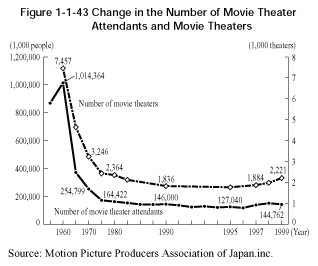
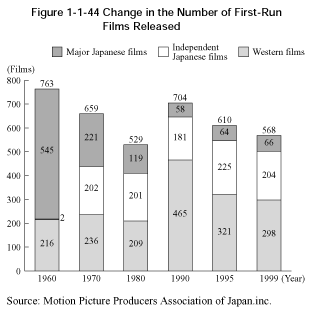
On one hand, the number of movie theaters has been on the increase in recent years-in 1999, there were 2,221 theaters, an increase of 228 over the previous year (See Figure 1-1-43 ). The primary reason for this increase is the appearance of foreign-owned complexes of movie theaters ("cinema complexes") and the fact that major Japanese movie companies have followed this trend.
In addition, the fact that a number of recent Japanese works have won international film festivals or become huge box-office hits is a cause for optimism (See Table 1-1-16 ).
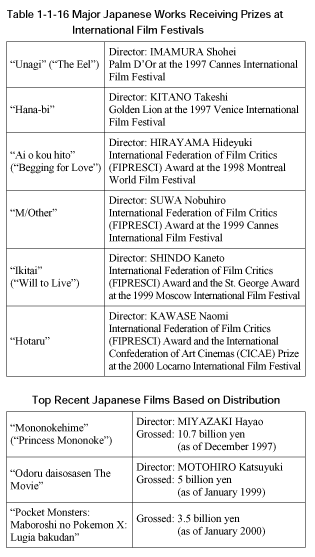
Recently, the number of big-budget films (so-called "blockbusters") has begun to decrease. Producers are searching for methods to reduce expenses as much as possible and to efficiently withdraw capital. One way is to actively submit works to overseas film festivals, win prizes, and sell the screen rights, which further improves the film's box-office performance in Japan. There have been some cases of entering film production from other industries.
With the developments in multimedia, the securing of a variety of image software which meets the demands of a diverse group of people has become an issue, and consequently, movies have begun to play an important role as a source of these images. At the same time, new experiments into "digital screening" methods, which project visual data directly onto a screen without using film, are being conducted. Faced with such conditions, the film industry is burdened by no small number of anxieties, such as securing production funding.
| {2} Animation |
In Japan, animation places high in box office records every year. In addition, recognition and evaluation of Japanese animation overseas is high, and many animated television programs produced in Japan appear on television in foreign countries. It is said that Japanese animation is a fine and unique form of expression due to the techniques of Japanese artists, and there are high expectations for it in the future. However, many problems have been pointed out, such as the fact that production companies are often small in scale and financially shaky.
In 2000, "Anime Gold-In Search of a Launchpad for Japanese Animation" was held at the Kawasaki Municipal Museum, which exhibited materials related to animation, focusing particularly on works from the 1960s.
| {3} Manga |
Of all published material, comics comprise approximately 40% of circulation and 20% of sales (See Figure 1-1-45 ). The age of readers spans a broad range, from young children to adults, and there are a wide variety of styles, including traditional four-panel cartoons, comics about hobbies and sports, and ladies' comics.
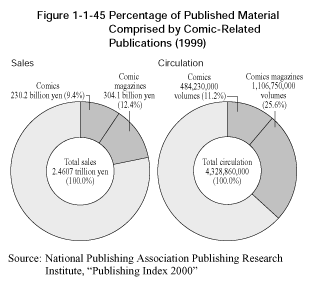
There is a strong interest in Japanese manga and anime overseas. For example, an exhibit entitled "MANGA" was held in France in 1999.
In Japan, manga has even been taken up in museums. From 1990 to 1991, "The Osamu Tezuka Exhibition" was held at the Tokyo National Museum of Modern Art, the Aichi Prefectural Museum of Art, the Kobe City Museum, and the Fukuoka City Museum. Recently, the Tokyo Metropolitan Art Museum held an exhibit entitled "The Manga Age-From Tezuka Osamu to Evangelion" in 1998, which was an attempt to reflect on the history of manga in Japan. This trend is expected to expand the scope of activities conducted by art museums, and to contribute to the stimulation of modern art.
In addition, the Hiroshima Manga Library was opened in 1997 as a public library specializing in manga, and many local development projects have started to make use of manga. Furthermore, there has been a trend towards studying manga as an academic discipline, exemplified by the manga course established at Kyoto Seika University in FY2000. Increasingly, manga has also served as the basis for movies and television dramas. In this way, manga is becoming recognized as an important form of modern expression.
| {4} Television and Radio |
There are a great number of television and radio productions of high artistic quality. The Agency for Cultural Affairs, starting in FY1996, established a Television and Radio Division in the National Arts Festival held every fall, and have approved inventive works with enthusiastic content to participate in the festival. Of these works, the Minister of Education, Science, Sports and Culture bestows the National Arts Festival Grand Prize, the National Arts Festival Excellence Award, and the National Arts Festival Individual Broadcasting Award on organizations which have been particularly successful. Every year there are many entries for participation in the festival; in 1999, 82 productions participated. There are a particularly large number of television documentary entries, some of which are entries from local broadcasting stations. Furthermore, the Hoso-Bunka Foundation provides support for research, development, surveys, and cultural activities that contribute to the development of broadcasting culture, and awards the Hoso-Bunka Foundation Prize annually for contributions to broadcasting culture.
At the same time, while broadcast programs serve as valuable historical and cultural data for the people which reflect the political, economic, and social climate of the time, they have often been erased or lost after broadcasting or their quality has deteriorated over time. Therefore, it is crucial to collect and preserve past and present broadcasting programs in an organized and sustainable manner, and to establish a system so that a wider range of people can appreciate them.
The Broadcast Programming Center of Japan's Broadcast Library is Japan's only program library based on the Broadcast Law. The Library collects and stores culturally and historically valuable broadcast programs, and makes available 5,800 television programs and 1,500 radio programs (as of the end of March 2000) to the public. Furthermore, NHK is planning the establishment of the NHK Archives in order for the integrated preservation and storage of images that are currently scattered among several facilities, and to work towards their multipurpose use and social restoration.
| {5} Digital Arts |
Through computer graphics (CG), it is possible to create images that are impossible to achieve through traditional photography or drawing. The movie "Toy Story," which was a major hit internationally, was entirely created by computer graphics, proving that computer graphics are a richly expressive art form that enables the creation of attractive artistic images. Computer graphics were also used in the 1999 Japanese movie "Fukuro no Shiro" (Owl's Castle). It is expected that computer graphics will not only exert a great influence on established forms of art and contribute to the improvement of artistic standards, but will be further developed as a completely new form of artistic creation.
Also, in recent years, technologies such as computer graphics used in game software are supported by a broad range of fans, and are developing as a comprehensive art form for the multimedia age. Although there are calls for restrictions on game software due to concerns about its effects on the minds and bodies of youth, popular game software is even influencing other artistic fields, being featured, for example, in ballet and orchestral performances.
Although not entirely concerned with digital arts, the Department of Inter Media Art established at the Tokyo National University of Fine Arts and Music in FY1999 has come to attention. The course attempts to expand the scope of artistic expression beyond the limits of traditional forms of expression by, for example, conducting educational research on video media and computer media.
In order to maintain, develop, and create sophisticated arts and culture, activities which support artistic creation are essential to forge a link between providers and receivers of culture. These activities include art management and stage techniques.
| {1} Art Management |
Art management is the general term for the operation of cultural facilities, the activities of arts organizations, or activities designed to make art-related events more effective and successful. The nature of these activities covers a wide scope, but specifically, art management includes management-related work such as planning, accounting, and organization, as well as public relations and marketing.
In today's situation, where attention has been drawn to the necessity of art management, the continued establishment of cultural facilities such as national culture halls and art museums, calls for increased support for cultural activities by private corporations, and the strengthening of management bases to give momentum to the creative activities of arts organizations have become important issues. In particular, considering the recently severe economic climate, it will be necessary for artists and art organizations to make effective and efficient use not only of financial assistance from the national government, local governments, and the private sector, but also various resources intrinsic to society such as human resources, technology, and information. Also, it is necessary to communicate these responsibilities to society as a whole in order to create an environment where it is easy to receive public and private assistance. In regard to these issues, the importance of art management is rising.
Although it is difficult to get a clear picture of the people engaged in art management, according to a 1996 survey arts organizations by the Japan Council of Performers' Organizations, there were an average of 5.2 full-time administrative employees and 4.3 full-time production staff per arts organization. According to a 1995 survey by the Agency for Cultural Affairs looking at public culture halls, there were an average of 7.4 full-time administrative employees at each facility. Furthermore, according to the "The 7th Survey on Activities and Living Conditions of the Japanese Performing Artists in 2000" published by the Japan Council of Performers' Organizations, "lack of human resources to draw up good performance projects" was most often cited as an obstacle in promoting artistic activities, followed by "lack of financial support system" (See Figure 1-1-46 ). It appears as though conditions involving the securing of art management personnel are unsatisfactory.
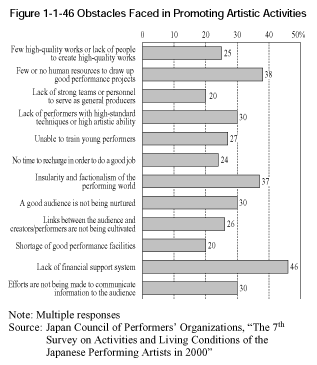
As a result, establishing conditions for the training of personnel engaged in art management has become an important task. Various governmental and private-sector institutions have begun to conduct education and training activities related to art management.
The Agency for Cultural Affairs offers training opportunities both in Japan and overseas for people responsible for art management at arts organizations through programs such as Overseas Study Program for Artists. It is also conducting "art management training" for staff involved in the management and operation of public culture facilities.
The Department of Literature at Keio University has held an art management seminar since FY1991, which accepts not only university students but also many members of society who wish to attend. In FY1994, the Showa Academia Musicae established a course for art management.
In the private sector, Toyota Motor Co. Ltd, with the cooperation of the Association for Corporate Support of the Arts, has held the "Toyota Art Management Lecture" since FY1996 as part of its mecenat activities. In addition, associations and federations made up of artists and art organizations, such as the Japan Council of Performers' Organizations, are also conducting workshops.
| {2} Stage Techniques |
In fields such as stage arts, film, and television, important roles are played by experts in lighting, sound, and stage design. These specialists do not merely exercise techniques and operate machines, but are responsible for emphasizing artistic expression, drawing upon their artistic sensibilities, and actively participating in creative activities.
There are a wide range of jobs related to stage techniques. Looking from the state of organizations in major fields, in the field of lighting there is a group called the Japan Lighting Technicians Association which is made up of approximately 3,200 individual experts. This association offers Level 1 and Level 2 certification through an annual certification exam for stage and television lighting technicians, in order to establish certain standards for lighting techniques, lighting art, and safety.
As far as organizations in the field of sound, there are the Stage Sound Association of Japan and the Sound Engineers and Artists Society of Japan. The Stage Sound Association of Japan was launched in January 2000 when two organizations combined, and is made up of approximately 500 individual members who work as sound technicians for plays and concerts, as well as approximately 30 organizations. The Sound Engineers and Artists Society of Japan is made up of approximately 550 individual members who work as sound technicians for plays. Since 1997, this association has certified the qualifications of approximately 700 sound technicians in order to establish a certain level of expertise and improve the status of sound technicians.
Although the work of stage directors is not uniform, it generally consists of providing cues for performers, drafting and executing a budget for all stage arts, preparing and managing schedules, and coordinating and directing various tasks involving stage techniques. Both the Japan Stage Directors' Association (established in 1972), which centers on stage directors of dance and opera, and the Stage Management Association (established in 1974), which focuses primarily on theater directors, are organizations for stage directors. However, the two groups merged in April 2000, forming the Japan Stage Directors' Association. Approximately 300 stage directors are members of this organization.
In addition, "stage arts" can be broadly defined to include "stage techniques." Approximately 200 stage artists and costume designers are members of the Japan Stage Artists Association.
In all of these fields, there exist a number of stage technicians and companies that perform activities independent of particular associations.
In the field of stage techniques, establishing conditions for the cultivation and securing of human resources has become a pressing issue, and it will be necessary to enrich the assistance provided not only to training conducted by the state, but also that implemented by private sector institutions such as arts organizations. It will also be essential to establish measures to assess levels of expertise regarding stage techniques by, for example, actively encouraging an accreditation service by private organizations which takes artistic creativity into consideration.
| {1} Publishing |
Since the mid-1950s, when Japan entered the age of mass production, the publishing industry has developed in quality and quantity, with the boom in paperbacks, collected editions, and encyclopedias. However, after the oil shock, publishing companies which have made magazines and comics their staple products have steadily exerted a great influence on the publishing world, which has inclined towards a system where the entire publishing industry revolves around magazine publishing.
Recently, the economic slowdown, the appearance of new media such as the Internet, and the increasing number of used bookstores and manga cafes have brought about changes in the publishing world.
Total sales of publications in 1999 amounted to 2.4607 trillion yen, the third consecutive year-on-year decrease (See Figure 1-1-47 ). Magazines comprise 60% of total sales. In addition, although 65,026 new books and 3,394 magazine titles were published, making for a wide variety of published material, the number of books published has decreased from the previous year for the first time in 13 years since 1986. Furthermore, while many small booksellers continue to go out of business, large booksellers have flourished remarkably.
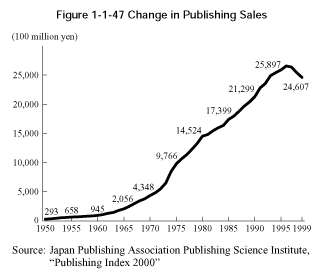
At the same time, with the advent of electronic commerce via the Internet and the digitization of out-of-print publications, there has been a rise in "on-demand publishing," or binding books according to orders. Additionally, there have also been experiments concerning the distribution of books via communications satellites and electronic books read through specialized computer terminals.
| {2} Literary Arts |
(a) Overview of the Literary World
The word literature ("bungei")-largely the same as another Japanese word for literature ("bungaku")-means an artistic work of linguistic expression.
A disparity has appeared between literary books that sell and those that do not, and while a small number of best sellers receive a lot of attention, it can be said that on the whole, the literary world is in decline-for example, the number of monthly literary magazines related to pure literature has fallen from seven to four.
(b) Pure Literature
Each time a literary magazine offers a literature prize for new authors, between 1,000 and 2,000 works are entered for consideration. At the same time, many people have voiced their concern that the younger generation in particular has only a superficial interest in literature.
Among the various literary coterie magazines, of which more than 100 volumes are published every month, there are more and more writers receiving not only literature prizes in a particular area but also central literature prizes.
(c) Various Novels
Novels are written in a variety of fields, such as historical novels, detective novels, science fiction, and adventure novels, and in addition, there are novels which combine these fields. Although it has recently become an international trend, non-fiction works such as documentaries have also become the fashion in Japan. Although novels which pursue truth in fiction are quite different in nature from non-fiction, non-fiction novels have attracted attention as one type of novel for the future.
(d) Poetry
Although more than 100,000 collections of poetry are currently in circulation, poetry generally tends to be shunned as something hard to understand. Among the places to present one's writing, there are specialized journals devoted to poetry such as "Gendaishi Techo," but poetry journals are generally published by a coterie.
(e) Tanka Poetry (31-syllable verse)
Although traditional publications such as "Araragi" and "Nyonin Tanka" have recently discontinued publication, tanka journals published by a particular association or coterie serve as the primary place to present one's work. There are approximately 600 such magazines.
(f) Haiku Poetry (17-syllable verse)
There are more than 700 magazines devoted to haiku, which, like tanka, are primarily published by a particular association or coterie. Recently, there have been experiments in holding poetry readings and haiku gatherings over the Internet. Haiku has also spread overseas, and contests are being held.
(g) Literature-related Organizations
The major organizations for literary artists are the Japan P.E.N. Club and the Japan Writers' Association. For poetry there is the Japan Modern Poets' Association; for tanka there is the Tanka Poets' Club of Japan and the Modern Tanka Poets' Association; for haiku there is the Modern Haiku Association, the Association of Haiku Poets, and the Association of Japanese Classical Haiku, as well as the Haiku International Association, which aims to further international exchange. There are also two student literary associations: the Japan Juvenile Writers' Association and the Japanese Association of Writers for Children.
(h) Prizes for Literature
There are more than 400 major literary prizes, including the Akutagawa Prize and the Naoki Prize. Prizes can be broken down into those awarded for novels, general literature, juvenile literature, plays/scripts, poetry, haiku/senryu (a short humorous poem), tanka, and non-fiction/criticism/essays.
| {1} Tea Ceremony |
It is estimated that between five and six million people study the art of tea ceremony. There are a great number of existing schools, including the Omotesenke, Uransenke, Mushakojisenke, Yabuuchi-ryu, Enshu-ryu, Sohen-ryu, Sekishu-ryu, Oribe-ryu, Yuraku-ryu, Matsuo-ryu and Edosenke schools. The tea ceremony is an important aspect of Japanese life and culture, and also has many devotees internationally. At present, there are 14 incorporated nonprofit organizations related to the tea ceremony under the authority of the Agency for Cultural Affairs, including the Omotesenke Domonkai and the Sado Urasenke Tankokai. At the same time, although more people use matcha (green tea powder) rather than sencha (green tea leaves), because sencha is more familiar to people, and consequently, there has been a steady increase in its use. Of the currently-existing schools, 38 have gathered to form the Japan Sencha Federation.
| {2} Flower Arrangement |
There are believed to be more than 1,000 schools of flower arranging, with the largest schools-represented by the Ikenobo, Ohara, and Sogetsu schools-having more than one million students. There are 15 incorporated nonprofit organizations related to flower arrangement under the authority of the Agency for Cultural Affairs. One of these is the Nihon Ikebana Geijutsu Kyokai, made up of 416 schools, which conducts national promotion activities; some schools which do not belong to this association have organized the Nihon Kado Renmei. Flower design is becoming integrated and promoted along with traditional flower arranging, and the Japan Flower Designer Association has been established.
The beginnings of the practice of bonsai can be seen from the Kamakura period (1185-1333), and has taken hold amongst the Japanese people, centering around the Nippon Bonsai Association, which conducts a great number of activities to promote bonsai overseas.
| {3} Calligraphy |
Calligraphy uses letters as a medium through which beauty expressed. This art is particularly appropriate for the culture of Chinese characters, and is created by manipulating a brush flexibly at various speeds. Calligraphy began in ancient China and spread to ancient Japan. When Japan's own form of writing, called "kana," was invented, the domain of calligraphy spread even further, penetrating deeply into Japanese culture, and being passed down from generation to generation. At present, there are believed to be more than ten million people who enjoy calligraphy.
Calligraphy has a long history of tradition, but the calligraphy of today, in addition to classical calligraphy such as conventional Chinese characters and kana, has become established as a form of expression involving a mixture of Chinese and Japanese phonetic characters as well as more avant-garde writing. Although there are young people who have become interested in calligraphy of Chinese characters, there are concerns that the number of people who study calligraphy is decreasing.
Although the games of go and shogi have different origins, they share the characteristic of both being board games that are played one-on-one. Both games, which have spread widely since the Edo period, have a long history, and are a form of entertainment that has taken hold amongst the people.
At present, there are believed to be approximately 4.1 million players of go and 9.9 million players of shogi, but this number continues to decline as a result of the diversification of forms of entertainment (See Figure 1-1-48 ).
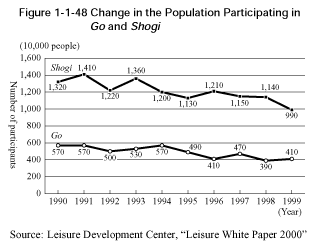
In terms of national organizations, there is the Nihon Ki-in for go and the Japan Shogi Association for shogi, and both groups are working to popularize these games.
| {1} Go |
The game of go originated in China, and the first record of it being enjoyed in Japan dates from the Nara period (710-794). Since then, it was played among the upper classes, and at the beginning of the Edo period, it developed to the extent than a special go room was added to the shogunate. From the Meiji and Taisho periods until after the war, a great deal of interest in go was accumulated as newspaper companies published the names of go championship title holders, and the games spread rapidly. Professional go competitions consist of seven major titles-the Kisei, the Meijin, the Honinbo, the Judan, the Tengen, the Oza, and the Gosei-for which there is fierce competition.
At the same time, in order to raise the technical ability of national go fans and expand its base, various go competitions were organized, such as the Nihon Ki-in Amateur Go Championship, the All-Japan Amateur Honinbo Title Match, and the All-Japan Amateur Grand Champion Title Match. Also, in recent years, go has spread around the world. 57 countries are members of the International Go Federation, which has more than 30 million members.
| {2} Shogi |
It is said that shogi has its ancestry in a game called chaturanga which originated in ancient India. The game spread west to become chess in Europe and the U.S., and north to become xiangqi in China, and finally reached Japan via Southeast Asia. It is recorded in literature dating from the 11th century, flourished during medieval times, spread from the warrior class to the townspeople at the beginning of the Edo period, and continues to be enjoyed by many people today.
Major bouts between professional shogi players have continued to enthrall fans through the media, and players devote all their energies towards acquiring the seven major shogi titles-Ryuo, Meijin, Kisei, Oi, Oza, Kio, and Osho.
The Japan Shogi Association expends a great deal of effort into training professional shogi players, but at the same time, works to increase the number of shogi fans through competitions such as the All-Japan Amateur Shogi Tournament and the Amateur Ryuo-sen.
Shogi, which has a special characteristic in that the pieces can be reused after they are captured, is spreading not only in Japan but also overseas among fans of similar games such as chess and xiangqi, and the number of shogi fans and associations abroad is steadily increasing.
Over the long course of its history, Japan has developed a highly unique and rare traditional gastronomic culture, which continues to achieve original developments. The Japan Gastronomic Culture Foundation conducts comprehensive research on the culture of eating and activities to disseminate knowledge about eating habits. Through the activities of related organizations, including the Japan Gastronomic Culture Foundation, which work towards the preservation, succession, and creation of Japan's gastronomic culture, interest among the Japanese people towards traditional eating habits is increasing.
Also, regarding fashion, organizations such as the Japan Kimono Culture Association and the Folk Costume Culture Promotion Association conduct activities to promote information about Japan's excellent fashion culture, and work to pass on the traditional techniques of folk clothing such as kimono and encourage research.
The collapse of the bubble economy inflicted heavy damage to the Japanese architectural world. With the fall in land prices, the slowdown in real estate value and the decrease in new projects, there do not appear to be any signs of recovery.
However, in the case of large-scale architectural projects, it requires an enormous amount of time to progress from the planning and design stages to actual completion. As a result, during the early 1990s, large-scale construction projects conceived during the bubble period were accomplished one after another despite the economic slowdown. Buildings designed by foreign architects were constructed, particularly in urban areas, and a succession of large-scale public buildings were completed. Particularly in Tokyo, large-scale buildings have been completed, including the new Tokyo Metropolitan Government building designed by TANGE Kenzo, the Tokyo International Forum, and the New National Theater, which has generated new activity in the city.
At the same time, in terms of design trends, the unconventional designs of the post-modern style that were the fashion during the bubble era have fallen out of favor; instead, many buildings utilizing a refined form of the earlier modernism style or more simple designs have begun to be built. This is believed to be a result of the gloomy economic mood, which eliminated opulent decorations, but many architects are paying more attention to the urban and social relationships between the building and its surroundings, attempting to create a more visually pure and clear style of architecture. Also, 50 years after the end of the war, there is a flourishing debate over the need to hand down to future generations the cultural heritage of modernist architecture from the late 1950s. On the whole, there are calls for a redefinition of modernism, a design movement of the 20th century.
Also, with the recognition of the need for environmental measures, there are increasing demands for conservation of building resources, resource recycling, harmony with the environment, longer-lasting buildings, and the strengthening of renovation technologies. Painful memories of the Great Hanshin-Awaji Earthquake have led to a reevaluation of the value of existing buildings and an increased interest towards movements to restore and utilize them. This trend is indicated by the establishment of a registration system for cultural properties (a new system for preserving historic buildings) as well as designation of large-scale modern architecture in urban centers as important cultural properties.
Faced with the slowdown in the economy and land values, the architectural world is searching for a new means of survival, in which environmental measures will be an important issue. There is also a pressing need to develop plans for buildings and cities that correspond to an aging society, such as barrier-free buildings. The time has come to create cities from a long-term perspective, including further utilizing historic buildings while improving safety.

The appreciation and creation of gardens, as well as horticulture, are cultural activities that reveal the intimacy between the Japanese people and nature.
Historic Japanese gardens with artistic and ornamental value have been designated as Places of Scenic Beauty, which is one of the categories of cultural properties. At present, 160 gardens have been designated as Places of Scenic Beauty by the national government, and many others have been designated as such by prefectural and municipal governments. These historic gardens are carefully managed on a daily basis by their owners and others, and are generally open to the public. Gardens designated as Places of Scenic Beauty express the attitude of Japanese people towards nature during the era in which they were created, and serve as ideal places for Japanese people living in the present day to develop an appreciation for traditional aesthetics. They also function as an oasis where people can experience natural settings in a peaceful atmosphere. Many guidebooks introducing the gardens of various regions have been published, and Japanese horticulture, nurtured throughout its long history, is familiar among Japanese people.
Garden-building activities are also becoming widely popular. Through the trend towards every family owning their own home, small gardens based on traditional design are being created in the yards of many detached houses. Recently, "gardening"-decorating small spaces like entryways, verandas and roofs of apartment complexes by placing flowerpots full of flowers or planting small trees-has become very popular.
Horticulture, which the Japanese people have been familiar with since the Edo period, is experiencing a revival along with the boom in natural history. Events selling horticultural goods, such as plant fairs, are held frequently, and shows and exhibitions of a particular variety of plant including bonsai exhibits, chrysanthemums, peonies, irises are held in various areas and enjoy a favorable reputation. The fact that expositions are being held on the themes of horticulture and landscaping, such as the International Garden and Greenery Exposition held in Osaka Prefecture in 1990 and the International Gardening and Landscaping Exhibition (Japan Flora 2000) held on Awaji Island, Hyogo Prefecture in 2000, indicates the increasing awareness towards conserving the natural environment and the increasing interest in gardening.
In connection with the spread of cultural activities related to landscaping that were mentioned above, demand for garden designers is increasing. Also, seminars on acquiring licenses to become landscape engineers, etc., are being held in order to train specialists with high-level skills related to landscaping such as garden management technology. Various landscaping activities are being unveiled not only in the fields of horticulture and landscaping but also focusing on wide open spaces such as public parks. In particular, activities such as the maintenance of historic sites as public parks and the rehabilitation of archaeological and historic sites that have been discovered are being extensively conducted, which is characteristic of the present day. Of these, various landscaping techniques have been adopted, including reconstruction of historic buildings that have been destroyed and symbolic expression of aspects of ancient ruins (for example, by using trees), and these techniques are being established as one of the fields in which landscape architects are active.
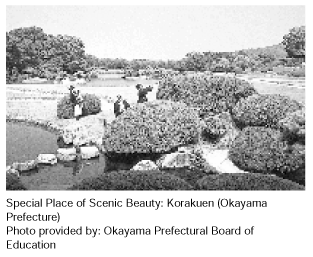
| Back to Top | MEXT HOME |